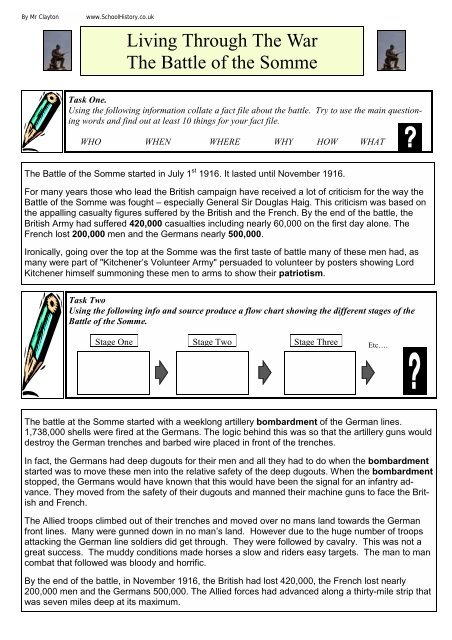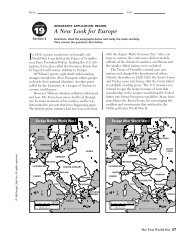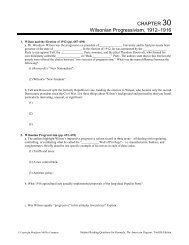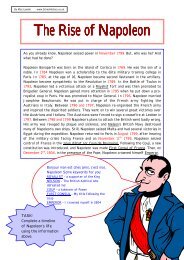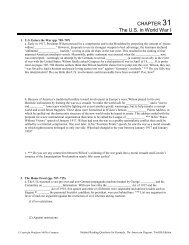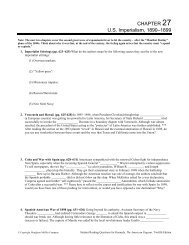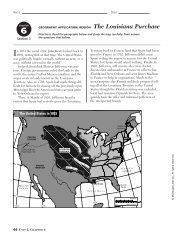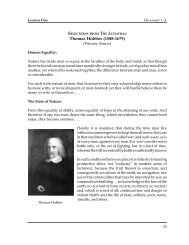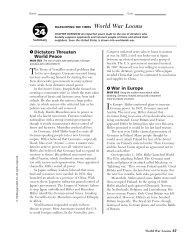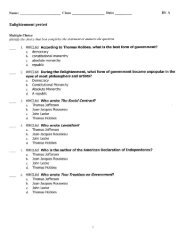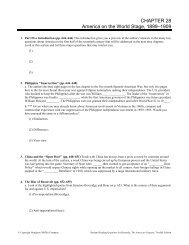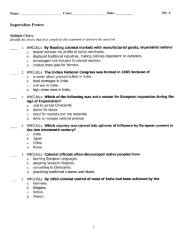Battle of the Somme.pdf - School History
Battle of the Somme.pdf - School History
Battle of the Somme.pdf - School History
You also want an ePaper? Increase the reach of your titles
YUMPU automatically turns print PDFs into web optimized ePapers that Google loves.
By Mr Claytonwww.<strong>School</strong><strong>History</strong>.co.ukLiving Through The WarThe <strong>Battle</strong> <strong>of</strong> <strong>the</strong> <strong>Somme</strong>Task One.Using <strong>the</strong> following information collate a fact file about <strong>the</strong> battle. Try to use <strong>the</strong> main questioningwords and find out at least 10 things for your fact file.WHO WHEN WHERE WHY HOW WHATThe <strong>Battle</strong> <strong>of</strong> <strong>the</strong> <strong>Somme</strong> started in July 1 st 1916. It lasted until November 1916.For many years those who lead <strong>the</strong> British campaign have received a lot <strong>of</strong> criticism for <strong>the</strong> way <strong>the</strong><strong>Battle</strong> <strong>of</strong> <strong>the</strong> <strong>Somme</strong> was fought – especially General Sir Douglas Haig. This criticism was based on<strong>the</strong> appalling casualty figures suffered by <strong>the</strong> British and <strong>the</strong> French. By <strong>the</strong> end <strong>of</strong> <strong>the</strong> battle, <strong>the</strong>British Army had suffered 420,000 casualties including nearly 60,000 on <strong>the</strong> first day alone. TheFrench lost 200,000 men and <strong>the</strong> Germans nearly 500,000.Ironically, going over <strong>the</strong> top at <strong>the</strong> <strong>Somme</strong> was <strong>the</strong> first taste <strong>of</strong> battle many <strong>of</strong> <strong>the</strong>se men had, asmany were part <strong>of</strong> "Kitchener’s Volunteer Army" persuaded to volunteer by posters showing LordKitchener himself summoning <strong>the</strong>se men to arms to show <strong>the</strong>ir patriotism.Task TwoUsing <strong>the</strong> following info and source produce a flow chart showing <strong>the</strong> different stages <strong>of</strong> <strong>the</strong><strong>Battle</strong> <strong>of</strong> <strong>the</strong> <strong>Somme</strong>.Stage OneStage TwoStage ThreeEtc….The battle at <strong>the</strong> <strong>Somme</strong> started with a weeklong artillery bombardment <strong>of</strong> <strong>the</strong> German lines.1,738,000 shells were fired at <strong>the</strong> Germans. The logic behind this was so that <strong>the</strong> artillery guns woulddestroy <strong>the</strong> German trenches and barbed wire placed in front <strong>of</strong> <strong>the</strong> trenches.In fact, <strong>the</strong> Germans had deep dugouts for <strong>the</strong>ir men and all <strong>the</strong>y had to do when <strong>the</strong> bombardmentstarted was to move <strong>the</strong>se men into <strong>the</strong> relative safety <strong>of</strong> <strong>the</strong> deep dugouts. When <strong>the</strong> bombardmentstopped, <strong>the</strong> Germans would have known that this would have been <strong>the</strong> signal for an infantry advance.They moved from <strong>the</strong> safety <strong>of</strong> <strong>the</strong>ir dugouts and manned <strong>the</strong>ir machine guns to face <strong>the</strong> Britishand French.The Allied troops climbed out <strong>of</strong> <strong>the</strong>ir trenches and moved over no mans land towards <strong>the</strong> Germanfront lines. Many were gunned down in no man’s land. However due to <strong>the</strong> huge number <strong>of</strong> troopsattacking <strong>the</strong> German line soldiers did get through. They were followed by cavalry. This was not agreat success. The muddy conditions made horses a slow and riders easy targets. The man to mancombat that followed was bloody and horrific.By <strong>the</strong> end <strong>of</strong> <strong>the</strong> battle, in November 1916, <strong>the</strong> British had lost 420,000, <strong>the</strong> French lost nearly200,000 men and <strong>the</strong> Germans 500,000. The Allied forces had advanced along a thirty-mile strip thatwas seven miles deep at its maximum.
Images <strong>of</strong> <strong>the</strong> <strong>Battle</strong>British soldiers going 'over <strong>the</strong> top' at <strong>the</strong><strong>Somme</strong>A British machine gun post at <strong>the</strong> <strong>Somme</strong>Lord Kitchener was a supporter <strong>of</strong> <strong>the</strong> <strong>the</strong>ory <strong>of</strong> attrition - that eventually you would grind downyour enemy and <strong>the</strong>y would have to yield. He saw <strong>the</strong> military success <strong>of</strong> <strong>the</strong> battle as all-important.However, it did have dire political and social consequences in Britain. Many spoke <strong>of</strong> <strong>the</strong> "lost generation".Many people found it difficult to justify <strong>the</strong> near 88,000 Allied men lost for every one milegained in <strong>the</strong> advance.Task ThreeProduce a First World War glossary. Add to it <strong>the</strong> following words and <strong>the</strong>ir meaning.Attrition Lost Generation ObjectiveBombardment Patriotism Trench WarfareNo man’s LandOver <strong>the</strong> top’"The Daily Chronicle" published this report on <strong>the</strong> battle on July 3rd:At about 7.30 o'clock this morning a vigorous attack was launched by <strong>the</strong> British Army. The front extends oversome 20 miles north <strong>of</strong> <strong>the</strong> <strong>Somme</strong>. The assault was preceded by a terrific bombardment, lasting about an hourand a half. It is too early to as yet give anything but <strong>the</strong> barest particulars, as <strong>the</strong> fighting is developing in intensity,but <strong>the</strong> British troops have already occupied <strong>the</strong> German front line. Many prisoners have already fallen intoour hands, and as far as can be ascertained our casualties have not been heavy.However, those who fought <strong>the</strong>re knew what really happened - if <strong>the</strong>y survived:The next morning (July 2nd) we gunners surveyed <strong>the</strong> dreadful scene in front <strong>of</strong> us......it became clear that <strong>the</strong>Germans always had a commanding view <strong>of</strong> No Man's land. (The British) attack had been brutally repulsed.Hundreds <strong>of</strong> dead were strung out like wreckage washed up to a high water-mark. Quite as many died on <strong>the</strong>enemy wire as on <strong>the</strong> ground, like fish caught in <strong>the</strong> net. <strong>the</strong>y hung <strong>the</strong>re in grotesque postures. Some lookedas if <strong>the</strong>y were praying; <strong>the</strong>y had died on <strong>the</strong>ir knees and <strong>the</strong> wire had prevented <strong>the</strong>ir fall. Machine gun fire haddone its terrible work. George Coppard, machine gunner at <strong>the</strong> <strong>Battle</strong> <strong>of</strong> <strong>the</strong> <strong>Somme</strong>.Task FourRead <strong>the</strong> two reports on <strong>the</strong> battle. Put <strong>the</strong> following headings and record five things that eachreports say about <strong>the</strong> battleNewspaper ArticleEye witness accountEXTENSION Which <strong>of</strong> <strong>the</strong> extracts do you trust <strong>the</strong> most? Why do you have this opinion?


